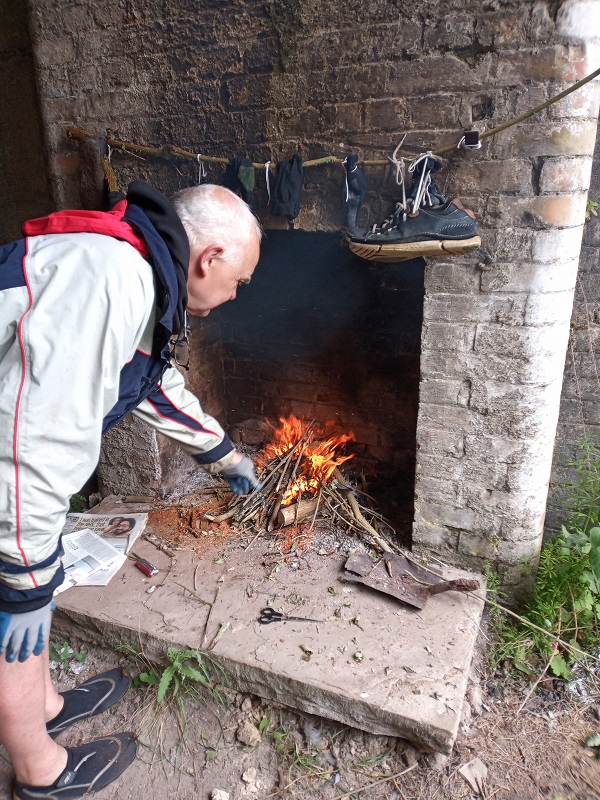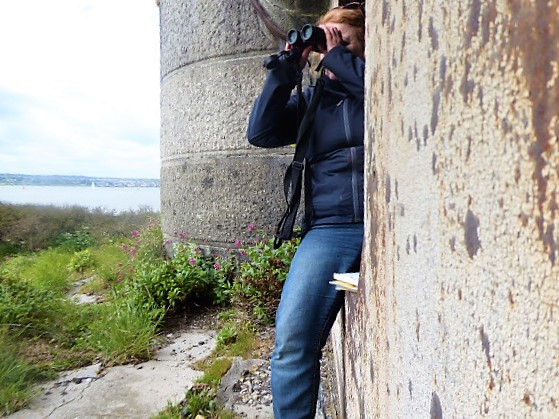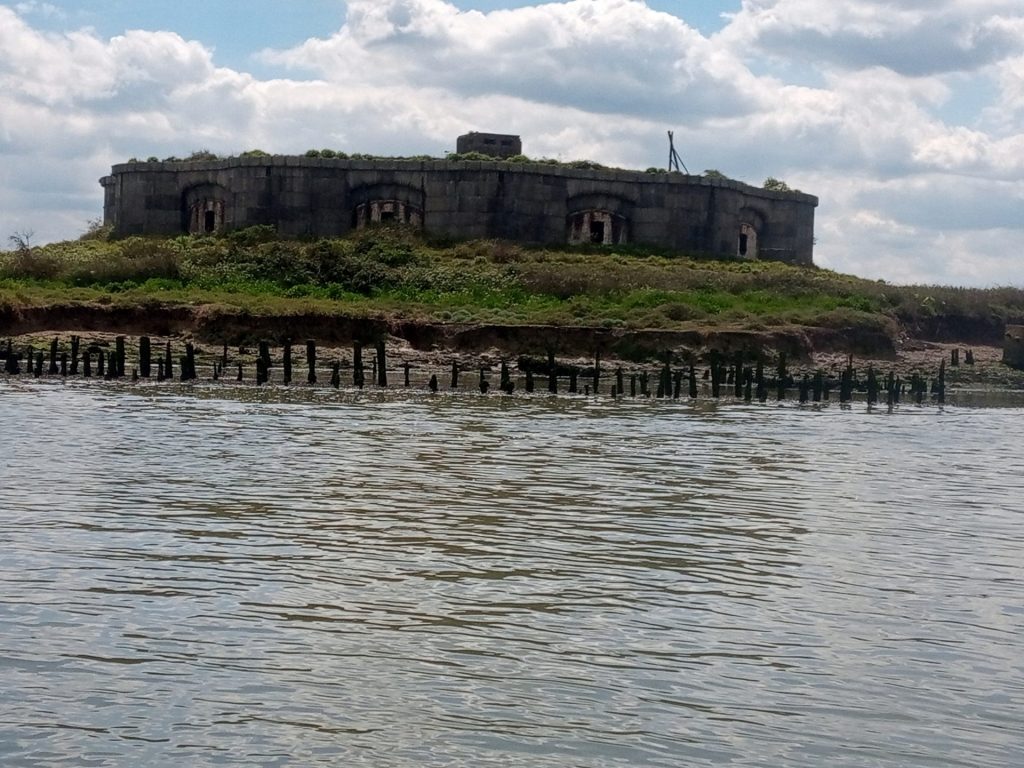Darnet became our island home during our trip. I look at it now, from across the water in the Medway towns and I miss it.





Darnet became our island home during our trip. I look at it now, from across the water in the Medway towns and I miss it.





A few photographs from my recent trip with Stephen Turner to the Medway Estuary. Day One we stopped off on Hoo Ness Island

The Blue Mermaid had just headed up river as we began to carefully stow all our kit into Magwitch, examining every item for the unwelcome brown tailed moth caterpillars encountered in huge numbers on Darnet. My arms, neck and legs were already beginning to show signs of the skin irritation caused by their toxic hairs, as Carol and I vigorously shook our tents and quickly packed them – to prevent any re-infestation near ‘emigration control’ on the narrow strip of shingle where Magwitch was waiting and where we made our leave.
Looking back from just offshore, we could see much of the flora around the fort had been devoured. The white cloud of hawthorn flowers I remember wrapped about the curve of the fort entrance on my last visit in 1998, looks now like a thing of the past. The entire thicket has been eaten to death and blossom replaced by cottony communal caterpillar tents woven about their twigs. Other plants were so densely covered in caterpillars they fell off leaves for lack of room. I saw scores falling into the water surrounding the fort where their long hairs kept them afloat, before drifting to shore and tenaciously climbing back over the mud to start eating again. One or two even tried eating me. There have been other documented outbreaks like this, but their numbers in consequent years decline as nature somehow redresses the balance.
It makes me wonder about our own viral spread across the planet as our 7.5 billion souls are predicted to increase to over 9 billion in the next 30 years unless we learn some self control or a Gaian spirit finds other ways to govern us. Is Covid19 part of nature’s master plan I thought, as I increased the throttle to counter a turning tide in Gillingham Reach and where we caught up with the Blue Mermaid.
She was anchored not far from the rusty John H Amos steam paddle tug boat, which has been awaiting restoration on the waterside for many years. I was put in mind of JMW Turner’s painting ‘The Fighting Temeraire’ of 1838, where a ghostly veteran sailing ship from the Battle of Trafalgar, is being towed to be broken up by a fiery steam tug in an allegory of the modern world replacing the old; but on this bit of the Medway in 2021 sail has outlived steam, wind outlasted coal.
We could have used a sail later, when the engine stopped for want of petrol and we had a frantic paddle to a nearby buoy to refuel. Then suddenly it seemed, No8 Slip was off the port bow and we were almost back. We could have both happily stayed down river for far longer and ‘Escaping with Magwitch 2’ is going into our diaries soon – but in a season with no caterpillars and no nesting birds.


The island has worked its magic, as islands often do. I stand at the gun emplacement window looking across the saltmarsh. I have been here how long? Half hour? Maybe more. Thinking of….nothing, just watching the sailing boats head out to sea and the terns fold their wings and dive for fish before emerging with a splash. The tide drifts in and, somewhere in the distance I can hear a cuckoo calling the hour away on Hoo Ness.
Outside, on the mainland I know it’s Friday. I can see real life carrying on. Lorries rush along the road to Grain, the never ending grind of sound from the building sites around Hoo St Werburgh can be heard across the water. In the Medway towns, people shop in face masks, drink lunchtime beer in pub gardens, race through office work so as to finish early for the weekend. It’s all out there and I know I must return but, just for now, I can stand at the window of my island fortress, doing nothing, peaced up to the nines.
www.naturegirlblogdotcom.wordpress.com
@estuaryfestival @stephenturnerartist

Darnet Fort is on the edge of the deep water channel used by all the boats and ships using the docks, moorings and marinas of the Medway and I enjoy watching them pass, whilst gazing out through a casement window of 10 inch thick steel daubed with a dot, dot, dot, dash and V for victory. The morse code reference probably dates it as a leaving present from the Observation Corps stationed here in WW2 when they left their isolated outpost for a final time after victory in 1945.
It’s easy to imagine Nelson’s flagship HMS Victory passing this spot en-route from the old Royal Dockyard in Chatham (where she was built and repaired) to Cape Trafalgar in 1805 for another famous victory. Meanwhile the opening ‘da – da – da – daaa’ of Beethoven’s 5th Symphony, which was written at around the same time, has got annoyingly lodged in my mind and won’t go away.
I can remember this same ‘graffiti’ from my visits in 1998 when I stepped outside to photograph a V formation of Canada Geese. After contemplating the meaning of victory, winning, success and achievement, it made me wonder more about exactly what in the world is being lost…

I was awake all night, first following the Moon (see the instagram feed), before transferring allegiance to the sun, which finally showed above the horizon at around 5am and threw its pink glow onto the grey granite interior of the fort. Bird song from the marsh without, had its counterpoint of blackbird and pigeon calls from within, with no breath of wind to interrupt or distort. I have hours ‘in the can’ to play with 🙂
I came close to crushing a clutch of herring gull eggs for the second time in eight years today, while Carol and I were exploring the perimeter of the fort on Darnet Island (The first time was on the Beaulieu River in 2013 when I was planning the live-work with nature project that became the Exbury Egg – www.exburyegg.me). I managed (both times) to step away, but I now can’t stop thinking again about the fragility of both these nesting sites and of nature in general, as we bestride the planet in our great size nines.
As sea levels rise and south east England slowly dips into the sea, the lower more remote parts of this and other nearby marshes frequently go under on high spring tides. It was particularly affecting to watch and hear the cries of over 200 pairs of gulls on Bishops Ness off to the east, as today’s flood tide washed through and over their nests. They settled down as the tide went out, but Carol’s more expert view than mine is that they will now have to start again. Yet there are high tides every month and the climate change we create will drive them higher.
Such is the pressure on these poor creatures that they are now nesting on the higher ground more frequently visited by people. What to do about the eggs we found today? They were still warm. Will the adults return? We kept finding more, ever closer to the fort itself and even upon it (we think the oyster catchers have colonised the roof). Should we even be here at all? We need to find a good and effective answer.

We are leaving the island, only for a few hours but we fear invaders will colonise during our absence. Not the hoards of invasive brown tailed moth caterpillars that swarm over every item we leave on the ground. No, those invaders were here first. We fear human Invaders. The island has become home.
“I’m going upstairs to fetch the water,” Steve says, referring to our fortress kitchen reached by crossing the moat on a scaffold plank that bounces and squeeks when you cross. On day one we edged across gingerly, now we are as sure footed as mountain goats. We have become Kings of a castle we both want to buy, secretly plotting to out bid each other for our 11 room villa with 360 degree river views at a mythical property auction we will one day attend with mythical savings we do not yet have.

I am queen bee of this hive, regally waving at passing sailing boats from my eerie as I keep watch on the channel.
We are reluctant to leave but keen to explore so we pack the things we least want stolen, binoculars, water and cooking equipment and heave Magwitch into the water, paddling slowly away before starting the motor.

We round the island, passing the silent cranes of Kingsnorth. It is not yet high water, I hang over the front of the boat checking depth with an oar as Steve guides us under one jetty and towards the broken struts of Jetty B.
The old wooden and metal pier has been hammer punched by wind. Twisted sections of wood and iron are strung out across the channel like a broken chain of French knitting

The oystercatchers are patrolling. These are the real Lords of the Estuary. On land I rarely see chicks but here a pair patrol every high mark and mud hummock. They pipe, pipe day and night, strutting in courtly dances, head down, back flattened. They march along the roof of the fort calling from beaks the colour of blood oranges.
We duck beneath the jetty, a broken sea creature, twisted in its death throws, beyond is the rusting remains of a German U-boat, spoils of war. destined to be cut up for scrap but somehow spared this ignominious fate. Now it rests in a slowly sinking mud coffin. A tourist destination that even Google maps recognises.

The tide is leaving us, the wind is picking up, water breaks across the bow. Jet skies churn past us at alarming speed, their riders lost in their own adrenalin rush. Magwitch is tossed around on a fair ground ride.
“There’s home,” Steve calls. The waves calm, terms skim low into the wind. The oystercatchers rush out.
“It’s our river, our island,” they call.
It seems we are the ones who are invading.
@estuaryfestival @stephenturnerartist

We are not wanted, that much is clear.
They haven’t got the memo, the sea pies, geese and gulls.
failed to get up to speed with the growing consensus that People Need Nature.
or maybe it is us that has failed to read the memo. Nature doesn’t need us. Doesn’t want us.
“Clear off, get lost,” the oystercatchers and greylags shout. “Get off our patch,” the herring gull cry.
“Be gone,” the caterpillars signal in shadow play, even as they attempt to crawl into our tents.
If i could understand the clap of a butterfly wing or the chemical message released into the wind by the sea purslane crushed beneath my boots I’m sure I would hear the same.
What are we to do, us, the great invaders, colonisers of islands?
Do we attempt negotiations? Draw up a peace treaty? Give ground? Withdraw to our cities and leave the wilds to the wildlife?
Do we attempt to bring it with us? Make space for it around our concrete fortresses? Create that feeling we get from nature in our own backyard?
What is this future deal we must sign? Because sign a pact we must.
We Need Nature but if we can’t meet its terms then all sides will lose.
www.naturegirlblogdotcom.wordpress.com
@estuaryfestival @stephenturnerartist